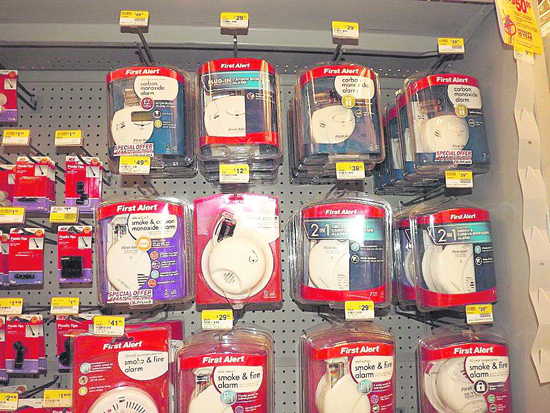 | | | Wide selection of detectors at a local hardware store Photo Cathy Dausman
| | | | | |
Smoke detectors have been required in California homes since 1987. But highly visible smoke and fire comprise only part of the deadly threat when something burns. It's time to install a second detector-this one for carbon monoxide. A new state law, Senate Bill 183, now requires single family homes with a fossil fuel burning appliance (think gas stove or water heater) or an attached garage or fireplace to install a working carbon monoxide detector. The bill took effect July 1, 2011. Apartments and hotels have until Jan 1, 2013 to comply.
 Carbon monoxide (CO) is the result of incomplete combustion. Carbon monoxide is produced when something burns without sufficient oxygen to make carbon dioxide (CO2). Unlike carbon dioxide, which occurs in nature and is tolerated by humans and animals at low levels, carbon monoxide binds to the body's red blood cells, prevents them from carrying oxygen, and eventually causes suffocation. Carbon monoxide, smoke and fire's evil twin, is invisible, odorless and tasteless. The Centers for Disease Control and Prevention (CDC) lists carbon monoxide symptoms as headache, dizziness, weakness, nausea, vomiting, chest pain, and confusion. High levels of CO inhalation can cause loss of consciousness and death.
Carbon monoxide (CO) is the result of incomplete combustion. Carbon monoxide is produced when something burns without sufficient oxygen to make carbon dioxide (CO2). Unlike carbon dioxide, which occurs in nature and is tolerated by humans and animals at low levels, carbon monoxide binds to the body's red blood cells, prevents them from carrying oxygen, and eventually causes suffocation. Carbon monoxide, smoke and fire's evil twin, is invisible, odorless and tasteless. The Centers for Disease Control and Prevention (CDC) lists carbon monoxide symptoms as headache, dizziness, weakness, nausea, vomiting, chest pain, and confusion. High levels of CO inhalation can cause loss of consciousness and death.
 CO detectors are similar in cost and operation to the now-familiar smoke detectors, and are readily available at hardware and home improvement stores as well as online. Combination smoke/CO detector units are also available.
CO detectors are similar in cost and operation to the now-familiar smoke detectors, and are readily available at hardware and home improvement stores as well as online. Combination smoke/CO detector units are also available.
 Moraga Orinda Fire District's (MOFD) Fire Marshall Michael Mentink says carbon monoxide detectors are "a good thing." Unit installation varies widely depending on the type of detector you buy, so Mentink advises homeowners to carefully read and follow the directions. Mentink says the National Fire Protection Association (NPFA) and most fire departments recommend replacing detector batteries every six months.
Moraga Orinda Fire District's (MOFD) Fire Marshall Michael Mentink says carbon monoxide detectors are "a good thing." Unit installation varies widely depending on the type of detector you buy, so Mentink advises homeowners to carefully read and follow the directions. Mentink says the National Fire Protection Association (NPFA) and most fire departments recommend replacing detector batteries every six months.
 Once a law is passed, the challenge becomes its enforcement. "Inspection of single family dwelling is somewhat restricted by law," says Mentink. Although fire departments support the installation of carbon monoxide detectors, regulation falls under building codes. For example, the presence of smoke detectors can only be verified by one of two "triggers": sale of a home, or issuance of a building permit of $1,000 or more. If an inspection shows a home to be without a working carbon monoxide detector the homeowner has 30 days to correct the violation before a fine ($200) can be levied. But Mentink says fire departments, including MOFD, are now including carbon monoxide detectors into their existing smoke detector public education campaigns.
Once a law is passed, the challenge becomes its enforcement. "Inspection of single family dwelling is somewhat restricted by law," says Mentink. Although fire departments support the installation of carbon monoxide detectors, regulation falls under building codes. For example, the presence of smoke detectors can only be verified by one of two "triggers": sale of a home, or issuance of a building permit of $1,000 or more. If an inspection shows a home to be without a working carbon monoxide detector the homeowner has 30 days to correct the violation before a fine ($200) can be levied. But Mentink says fire departments, including MOFD, are now including carbon monoxide detectors into their existing smoke detector public education campaigns.
 The California Air Resources Board says 30 to 40 people die each year from CO poisoning.
The California Air Resources Board says 30 to 40 people die each year from CO poisoning.
 These resources will familiarize you with the state law, CO symptoms and CO detectors:
These resources will familiarize you with the state law, CO symptoms and CO detectors:
 - Carbon Monoxide Poisoning Prevention Act of - Carbon Monoxide Poisoning Prevention Act of
 2010 http://sb183.com/
2010 http://sb183.com/
 - Carbon Monoxide: What You Need to Know is - Carbon Monoxide: What You Need to Know is
 available as a brochure from MOFD
available as a brochure from MOFD
 - From the California State Fire Marshall - From the California State Fire Marshall
 website: http://tinyurl.com/6hnupl7
website: http://tinyurl.com/6hnupl7
 - Carbon Monoxide poisoning info is online at - Carbon Monoxide poisoning info is online at
 the CDC: http://www.cdc.gov/co/faqs.htm
the CDC: http://www.cdc.gov/co/faqs.htm
 - The U.S. Consumer Product Safety - The U.S. Consumer Product Safety
 Commission has a Q&A page available online Commission has a Q&A page available online
 at http://www.cpsc.gov/cpscpub/pubs/466.html
at http://www.cpsc.gov/cpscpub/pubs/466.html

|
